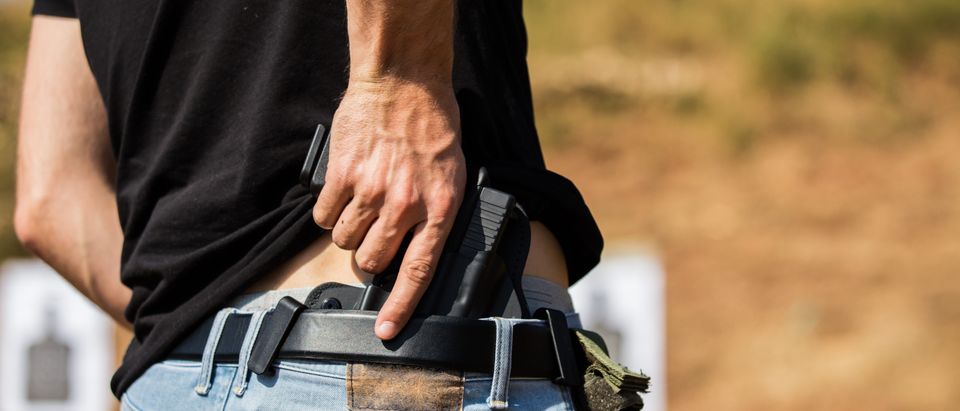By Sam Hoober, Alien Gear Holsters
A perpetual question among concealed carriers is whether or not to engage an active shooter if you happen to be around one.
It’s a valid question. Also, the thing about many mass shootings is that most of them occur in areas of commercial activity rather than schools or office buildings. Multiple mass shootings have occurred in Walmarts alone.
The question is whether or not you, as a person with a permit, training, and pistol in your concealed carry holster, should do something about it? This has both ethical and practical considerations.
As far as the ethical considerations, what you’re weighing is covering your own rear end first or confronting a threat to other people.
Consider this hypothetical: Say you’ve just walked into a shopping mall. You start hearing gunshots. They’re clearly coming from the other end of the mall, and you’re near the exit. Do you draw your gun and run toward the shots? Or do you usher anyone and everyone around you out the door as fast as possible and get to safety?
Would you hide? Run? Or ready yourself in case the shooter appears and you have to fire? Or try to find them to shut them down?
We all like to imagine that we’d charge in like Rambo or something, but it doesn’t always work out that way in real life. There was a fantastic scene in “Game Of Thrones” wherein a seasoned mercenary explains that in a real battle, “men die, men soil themselves, men run” meaning that there’s what happens in training or in one’s mind’s eye, but what happens in real life can be quite different when the metal meets the meat.
That much is up to you. We all have to make our own decisions and think about what the best course of action is or might be according to our own criteria.
Now to the practical considerations.
Obviously, there’s the risk of confronting an armed person. There’s also the risk of being misidentified as the shooter if police are on-scene already.
Concealed carriers have confronted active shooters and have been wounded. Concealed carriers have attempted to intervene and have been killed.
However, the odd thing is that when armed citizens do intervene, either in mass shootings or other violent crimes, they often have a high success rate.
ConcealedCarry.com did an analysis of mass shootings using FBI data from 2000 to 2017. Domestic incidents and gang-related incidents were excluded, and “mass shootings” were defined as an attacker using a firearm, and law enforcement as well as armed citizens had to be able to affect the outcome.
They identified 283 incidents during that time. Of those, 33 incidents – 11.7 percent – were known to have an armed citizen present. In 75.8 percent (25 instances) of those incidents, an armed citizen was successful in stopping the shooter, and in 18.2 percent of those instances or 6 of the 33 incidents, an armed citizen successfully reduced loss of life. An armed citizen was ineffective in either category only 6 percent of the time.
In one of the two incidents, the armed citizen was advancing on a shooter without knowing there was a second shooter, who shot him in the back. In the other, the shooter ambushed the armed citizen.
Reaching further back in history, Charles Whitman’s firing on the UT Austin campus was slowed dramatically by armed citizens – in conjunction with police officers – firing on the campus bell tower that he had set up in. That successfully bought time for the two officers who ultimately killed Whitman to advance on the tower, gain access and get up to the roof.
In 1915, Monroe Phillips went on a shooting spree in Brunswick, Ga., ultimately killing five and wounding 32 people. Two passersby ran into a hardware store and obtained a pistol and a shotgun. A police officer busied Phillips by shooting at him whilst the two men flanked the office Phillips had holed himself up in, ran in and shot him.
The young officer, according to a retrospective in the Brunswick News, one Rex Deaver, had only been on the job for two months and paid with his life. Phillips died soon after being shot by both pistol and shotgun fire.
Further back than that, the last bank robbery by the Younger-James gang in Northfield, Minn. in 1876 was put paid by armed citizens of that town. The robbers killed two, an assistant cashier and a bystander in the street who was shot by one of the gang prior to the townspeople opening fire on them.
The citizens of Northfield were smart, taking cover and waiting until the robbers emerged and letting them have it.
Two of the gang were killed outright, evening the score, and all six of the survivors were wounded for their pains. Four were captured within two weeks, one of whom – Bob Younger – died of tuberculosis while imprisoned. Frank and Jesse James escaped, though Jesse James would ultimately get his just desserts from Bob Ford.
There’s no right answer to this. Escaping danger is less risky than confronting danger, we all know this. It’s more that you have to consider what you believe to be best if you ever find yourself in that situation, and decide what you’re going to do.
Click here to get your 1911 Pistol Shopping Guide.
Click here to get The Complete Concealed Carry Training Guide
Sam Hoober is Contributing Editor for AlienGearHolsters.com, a subsidiary of Hayden, ID, based Tedder Industries, where he writes about gun accessories, gun safety, open and concealed carry tips. Click here to visit aliengearholsters.com.


